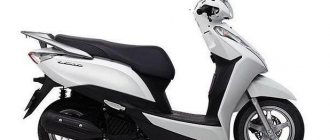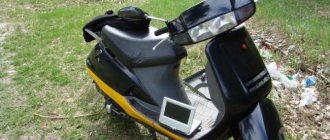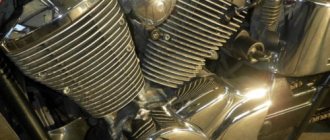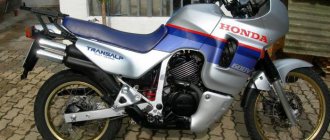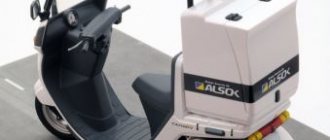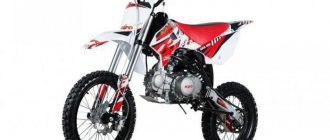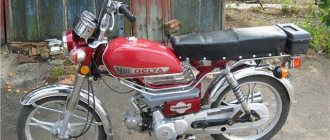Even a scooter like the Honda Lead AF-20 lends itself well to tuning. Considering the colossal safety margins of the frame, suspension and other elements, as well as the informative hydraulics for the front wheel, you can safely improve the technical characteristics without fear of consequences in the design.
Of course, this is not an instruction for tuning this device, but only my vision of the modifications of an experienced scooter rider. Each item was selected by trial and error. So, let's look at what this popular fifty-kopeck piece can show. There were no budget restrictions, so the installed parts were selected only from the point of view of expediency, despite the decent cost.
Main settings
The model was called “Honda Lead 50” and was a small-sized single-seater vehicle with a miniature two-stroke engine with a power of 5 hp. With. and consuming only 1.3 liters of fuel for every 100 kilometers. The engine volume did not exceed 49 cc/cm, and was air-cooled.
The Honda Lead 50 scooter did not have a gearbox; the transmission was a CVT type. The small car was distinguished by good maneuverability, the minimum turning radius was only 1.7 meters. The fuel tank held 5.3 liters of fuel.
Sales of the Honda Lead 50 have remained consistently high for six years. And when the scooter was modernized in 1984, received a more powerful engine and turned from a single-seater into a double-seater, the demand for it increased by an order of magnitude.
How does a carburetor work?
The carburetor design of the Honda Lead 90 scooter may seem complicated at first glance. But if you have a basic understanding of how nodes are arranged, you can figure out this block without any problems. Although it is better to entrust fine tuning and repairs to a specialist if you do not have the skills.
When the power plant is running, the pressure level in the carburetor decreases relative to the atmospheric pressure. Air enters the carburetor and combustion compartment, capturing fuel from the chamber, mixing with it, forming a mixture of fuel and air.
The gas handle on the steering wheel directly interacts with the valve and the metering needle fixed in it. When the gas is released, the needle completely blocks the fuel injection channel from the float-type chamber, and the damper blocks the flow of air. The more actively you gas, the higher the spool needle will rise and the more the fuel supply channel will be uncorked. Along with the needle, the air damper also rises. The volume of the fuel mixture naturally increases and enters the combustion compartment, where it is ignited by a spark plug.
1988 models
Six years after the start of production, the company released a new Honda Lead scooter with an AF-20E engine. The popularity of this scooter was amazing in its scope. At that time, there were two more 50cc models on the market, the Suzuki Adress and the Yamaha Axis. With the advent of the Honda Lead AF-20E, sales of Yamaha and Suzuki fell sharply. Dealers of the three leading Japanese companies had to share the sales market.
Technical characteristics of the Honda Lead AF-20 scooter:
- cylinder volume - 49 cubic cm;
- engine power - 6.5 liters. With.;
- torque - 0.73 at a speed of 6000 rpm;
- compression - 7.2;
- fuel consumption - 1.72 liters per 100 kilometers at a speed of 40 km/h;
- cooling - air;
- gas tank capacity - 7.2 liters;
- front brakes - disc, ventilated;
- Rear brakes are drum.
Regulatory process
The needle moves in small ranges relative to the air barrier. For this purpose, it has grooves where the corkscrew ring is mounted. It is installed in the middle cell. The bolt for adjusting the level and quality of the mixture is tightened all the way and unscrewed back one and a half turns. The scooter starts.
If there is no idle speed, or the speed is too low or high, use the adjusting screw to increase or decrease it. Then, by adjusting the mixture supply control screw, maximum speed is achieved, and screw it back a quarter or half a turn.
If there are dips when starting off, you will need to tighten the screw a quarter more. After each procedure, the idle speed is adjusted. If gasoline consumption is excessive, lower the spool needle another notch and readjust it. If the moped does not have enough fuel, there are dips, the needle is raised one notch up, and the adjustment process is repeated
Model HF05
The second most popular scooter was the Honda Lead 90, also created in 1988. The two-seater scooter was produced under the HF05 brand.
Weight and dimensional parameters of the model:
- dry weight 78 kg:
- total weight - 85 kg;
- landing height - 735 mm;
- ground clearance, ground clearance - 110 mm;
- center distance - 1235 mm;
- scooter length - 1755 mm;
- height - 1060 mm;
- width - 715 mm;
- Gas tank capacity is 7.2 liters.
Power point:
- cylinder volume - 89 cubic/mm;
- cylinder diameter - 48.0 mm;
- piston stroke - 49.6 mm;
- compression - 6.4;
- maximum power - 8.4 liters. With. at 6500 rpm;
- torque - Nm 1.0 at 4000 rpm;
- fuel consumption - 1.85 liters per 100 km at a speed of 50 km/h.
Other technical information
The scooter in question has a petal valve timing system and a variator with a diameter of 10.4 cm. Some other characteristics are presented in the table.
| Rear shock absorber height (cm) | |
| Tire pressure standard (kg/cm) | In front wheel (1.50), rear tire (1.75) |
| Voltage at maximum output current (A) | |
| Oil consumption per 1,000 km (l) | |
| Gearbox ratio | |
| Exhaust pipe | GW-3 with overflow pipe, internal diameter - 19 mm |
| Shock absorber length at centers (mm) | Front (260)/Rear (285) |
| Nominal resistance of resistors (Ohm) | |
| Brake fluid | |
| Speedometer cable length (mm) |
Next development
In 1998, production of another model of the popular scooter began. It was a two-seater Honda Lead 100 scooter. The new car was distinguished by its streamlined shape and a large headlight in one block with turn signals. The high-quality plastic lining flows smoothly around the wide double seat, giving the impression of solidity and good design.
The headlights include a powerful reflector with two built-in halogen lamps, creating a dual sharp beam of light that covers a sixty-degree wide area in front of the scooter. The taillights are not so powerful, their design corresponds to low-speed scooters, when powerful brake light and turn signal lamps do not make sense; 10-15 watt bulbs are enough.
Technical characteristics of the “hundredth” scooter
Honda Lead 100 engine, two-stroke, single-cylinder:
- cylinder volume - 101 cubic cm;
- cylinder diameter - 51 mm;
- piston stroke - 49.6 mm;
- cooling - air;
- compression - 6.5;
- maximum power - 9.3 liters. With. at 6750 rpm;
- torque - 1.0 Nm at a speed of 6000 rpm;
- fuel consumption - 2.32 liters per 100 kilometers at a speed of 60 km/h;
- Gas tank capacity is 7.5 liters.
Dimensions and weight parameters:
- scooter length - 1795 mm;
- height - 1060 mm;
- width - 680 mm;
- center distance - 1255 mm;
- ground clearance, ground clearance - 115 mm;
- rider seat height - 660 mm;
- turning radius, minimum - 2 meters;
- dry weight - 92 kg;
- total weight - 99 kg.
Scooter HONDA Lead 50 AF-20, scooter HONDA Lead 90 HF-05.
Pavel KURLAPOV, photo by Dmitry TYURIN
HONDA Lead 50 (AF-20), scooter, 1988-1998, 49 cm3, 6.4 hp, 15,000 - 30,000 rub.
HONDA Lead 90 (HF-05), scooter 1988-1996 89 cm3 8.4 hp 20,000 - 45,000 rub.
Remember the movie "Chasing Shadows"? The goofy mechanic Virgil said, “I don’t wear Jackal colors, but they need me—I fix their bikes.” So is this little hero: he rarely appears in ceremonial motorcycle columns and at biker cafes, but everyone needs him.
Instrument panels of “fifty dollars” and “nineties”. To understand which is whose, just look at the speedometer.
ADVENTURES OF THE JAPANESE IN RUSSIA.
Many motorcyclists have either already acquired a fifty-kopeck scooter or are planning to “buy some kind of scooter.” Because there is nothing more convenient in motorcycling than
scooter. What else can you use to drive to the kiosk for beer or to the spare parts store, digging through long evenings with a disassembled motorcycle? Or come to visit friends in a neighboring garage cooperative? Walking is lazy, riding a moto is not always comfortable, but sitting on a “stool” is just right. You don’t have to bother with expensive equipment, don’t worry about the headache after yesterday’s get-togethers, and you don’t have to worry about your license or technical inspection - just put on your helmet and off you go. And if the bike breaks down, the scooter will save you from “benching” during repairs. At least some, but wheels.
If someone says that the above can be attributed to any “Fifty Dollars”, they will be right, but only partly. Honda Lead is perhaps the only representative of the Japanese scooter industry that is almost ideally suited to the needs of the average Russian.
LOVE FOR MINIMALISM.
The Japanese are, for the most part, not a large people, and given the density of the country's population and urban development, it is not surprising why the Japanese are such minimalists. The apartment is so tiny, the car is like a snuff box, just so you don’t have to pay the parking tax. A typical Japanese scooter has such dimensions that even a person of average “Russian” height (which is about 175 cm) will find it, to put it mildly, a bit cramped. The knees rest against the steering wheel, even if you sit on the rack behind the saddle. Of course, the chassis of a “typical” scooter is designed for the average Japanese person (about 50 kilograms), driving on glass-smooth Japanese roads.
Instrument panels of “fifty dollars” and “nineties”. To understand which is whose, just look at the speedometer.
And then, for example, a Honda Pal or a Tact ends up in Russia, and a painfully familiar picture appears to our eyes: perched on a tiny saddle, with his knees spread out so that the steering wheel can fit between them, a hefty fellow rides along broken asphalt or a country road, and the poor “mapetka” ", creaking with all his joints, trying with his last strength to stay alive. The “leg” (the engine-transmission unit, which also performs the functions of the rear console pendulum) has long been twisted to one side by exorbitant loads and the wheel stands at an angle to the vertical axis of the scooter, the thin telescopic fork has long since “leaked” and is triggered before the rebound on every bump, well and how the frame moves can be seen almost with the naked eye. In a word, the picture is depressing.
WAY AWAY TO THE LEADER!
But Honda has a wonderful device called Lead. Despite the general similarity of design solutions with others, Lead has three important advantages. First, it's big. Secondly, he is reliable. And thirdly, it comes in 90 cc.
Ergonomics. Indeed, when designing the Lead, Honda engineers seemed to have European-sized people in mind. It is much larger and more spacious than its classmates. Perhaps, according to this parameter, Lead is the only “Japanese” capable of competing with the “Europeans” of its time (though the “Europeans” are unlikely to ever be able to compete with Lead on price). If on the same Dio it will be a bit cramped even for a girl taller than 170 cm, then on “Lida” only “Uncle Styopa” will rest his knees on the front shield, about ninety meters away. But the issue of landing is not only comfort, but also safety: you can’t “arrive” if the steering wheel gets tangled in your knees, especially in dense city traffic. And the 90 cc model, with the same dimensions, is considered a two-seater.
The Chinese oil pump is cheap, cheerful and very reliable.
Reliability. In terms of workmanship, Lead is certainly on par with all Japanese products. But this device, unlike most of its classmates, is equipped with a frame that would fit another “Maksik”. Thick pipes and stamped elements create a very rigid structure that can easily withstand wars with Russian roads. The wheel camber is not disturbed even after several years of active use. True, sometimes in this war the hydraulics of the rear shock absorber “perish”, but replacing the strut with a new Chinese or “original” used one will not shake even the leanest budget (see table at the end of the article), and even this work is within the power of a person far from technology. The same can be said about the front fork: the pull-type lever system is assembled from steel pipes and steel cast elements. The elastic elements are two classic shock absorbers. The suspension is capable of painlessly “digesting” almost any pit. Even if you set the goal to “kill” the fork, the maximum is that you will “run out” of shock absorbers. Even in this case, the fork will work, even though the oil will leak out. And if you approach the “killing” with all responsibility and zeal, then in a few years you may have to replace the worn-out steering column bearings. However, practice shows that most lead sellers almost never encounter this problem. In short, the Lead is truly a class leader in terms of “interior spaciousness” and indestructible chassis.
90 cc modification. This is what knowledgeable people value most. This is understandable: the chassis has such a significant margin of strength and rigidity that it can easily cope with the increased engine power. And the power in “almost one hundred” is as much as 8.4 hp. at 6500 rpm (versus 6.4 hp at 6500 rpm for the “fifty kopeck”) and 1 Nm at 6000 rpm (versus 0.7 Nm at 6000 rpm). “Ninetieth” easily reaches a speed of 100 km/h, and if you’re lucky with the engine and variator, then all 110. Moreover, the passenger has virtually no effect on the “maximum speed”. If we're talking about acceleration, let's talk about brakes. They exist - in principle, we can limit ourselves to this brief description. The front disc brake is quite tenacious and is enough to stop the scooter from any speed. The rear drum with mechanical drive perfectly complements the front one. In short, the design, which has been tested over the years, does not cause any complaints, and practically does not require attention to itself.
Another feature is that the “ninetieth” is practically indistinguishable from the “fifty kopecks” in appearance. Footpegs for the passenger, a strap across the saddle, and a speedometer marked up to 100 km/h instead of the classic “60” - that’s the whole difference. Otherwise, the devices are absolutely identical, the cladding parts, chassis and many other elements are interchangeable, so it’s quite difficult to immediately distinguish the older brother from the younger one, and if you try a little and tinker with the body kit, it’s completely impossible. True, law-abiding Japanese put a special sign on all scooters with an engine capacity of more than 50 cm3: a white triangle. It can usually be seen on the rear fender or on the plastic, in the area of the brake light. Of course, if the device has already “run” around Russia, the sticker could have been torn off, but if the scooter has just arrived from its homeland, this can become another “beacon” when the eyes wander across the orderly rows of equipment in the motorcycle showroom.
By the way, let me remind you that any equipment with an engine volume above 50 cm3 is considered a “mechanical vehicle”, and when purchasing in a showroom or by hand, you should be given not only a store receipt (or a sales contract), but also a PTS. Such a scooter must be registered with the State Traffic Safety Inspectorate, it must be issued an MTPL policy and undergo a technical inspection. Of course, category A license is also necessary.
INSTEAD OF A HEART - A BUTTER.
The power units of both modifications are incredibly reliable. Often in motorcycle dealerships you can see “Lids” with a mileage of over 40 thousand km, feeling quite cheerful. Of course, there are also outright junk on sale, but most often these are devices that have already been seen in Russia. Sellers rarely offer frankly “dead” equipment - expect hassle with complaints, and the image from such surprises is greatly spoiled, and this is almost the main engine of trade in conditions of fierce competition.
When choosing a vehicle, agree that the seller does not warm up the engine before the meeting. A cold start will tell you almost everything about the health of the engine. If the motor comes to life and begins to rumble smoothly when you briefly press the electric starter button, then most likely everything is in order. If you have to turn the starter for a long time or use a kickstarter, most likely the cylinder-piston group is worn out. The scooter cylinder is traditionally solid cast iron, so if there is no severe scuffing or rust on its surface, it will not have to be replaced, but the piston wears out much faster, and it needs to be replaced along with a set of rings and a pin, which is also subject to wear. If you are “choked by a toad”, instead of the original and expensive spare part, you can install a Chinese or Taiwanese analogue. True, such pistons last from 1 to 5 thousand kilometers, depending on the correct running-in, driving style and simply luck. And for the “original”, 40 thousand is not the limit.
The passenger footrests are another unmasking detail of the “nineties”.
The most common problem with both 50 and 90 cc engines is the failure of the oil pump of the separate lubrication system. The malfunction is detected quite simply: the piston begins to “seize” even in fairly quiet driving conditions. The reason for the lack of oil is that the plate against which the pump shaft rests is too thin, it bends, and the oil begins to “siphon” in all directions except the necessary one. This disease is treated by replacing the oil pump assembly. It is most often impossible to repair the old one. The best option is to install a Chinese analogue. Unlike pistons, the quality of oil pumps from the Middle Kingdom is almost not bad, and the price is not high. If there is nowhere to get a spare part or the breakdown occurs far from the store, but you need to travel, you can simply add oil directly to gasoline in the proportion indicated on the packaging of the oil itself. There will be more smoke and soot from the exhaust, but you will save the engine.
By the way, about soot: if the Lead is already elderly or the previous owners “fed” it not very good oil, the exhaust pipe becomes overgrown with soot and stops passing gases in the required volume, of course, you also have to forget about the “tuning” of the system as a whole. The engine loses “traction”, accelerates poorly, and the maximum speed drops. Before overhauling the engine or rebuilding the variator, burn the muffler can with a blowtorch - it is very likely that the disease will disappear. We recommend doing this procedure immediately after purchase.
The Lida variator is a reliable and well-functioning unit. So, most likely, during operation it will only require a planned replacement of the weights as they wear out. Clutch pads and belts “live” for a very long time, and these parts will not break the budget.
In terms of the volume of the “glove box” on the front panel, the Lead competes with other small cars.
The body kit suffers from the remaining “family diseases”. The first is that on almost all devices the rubber mat on the floor shrinks and bulges. Unfortunately, nothing can be done about this - this is the nature of the material. The second occurs less frequently, but nevertheless regularly. If the device had to drive with an overload (whether it was a passenger or a heavy pilot), the rather soft shock absorber was compressed to the point that the exhaust pipe sank under the plastic and the hot gases heated and melted the molding that encircled the perimeter of the lower part of the facings. That is why many people remove the molding either after it has melted, or they hang it on a nail in the garage in advance in order to return it to its place before a future sale.
BEST THE ENEMY OF THE GOOD.
Unfortunately, for those who like to tune the scooter beyond recognition, the Lead has been ordered (this means tuning the engine and variator, not external decorations). A tuning kit for its engine is almost impossible to find. And if for “fifty dollars” you can still find an “increased” CPG, then for “90” there is no tuning at all. Still, Lead is a purely utilitarian device, designed to move the average Japanese clerk from home to work, unlike, say, the same Dio, which has a “youth-bullet” orientation. The only advice that many mechanics give is to install lighter weights in the variator of the “ninety,” which smooth out the dip in acceleration at 30-50 km/h.
In 1998, the machine that had been in the series for ten years was replaced by a new generation, Lead, with engines of 49 and 101 cm3. The new car, although it has retained family features, has practically nothing in common with our hero. The design became smoother and more rounded, the lever fork, which was so appropriate in Russian directions, gave way to the usual “telescope”, but the archaic single-piston front brake caliper sank into oblivion, and was replaced by a two-piston one. In addition, the new Lead is equipped with a combined braking system. The engine has also changed a little. In the “toilet bowl” (as scooterists lovingly call the seat tank) there is a lock that locks the central stand in the open position (something that’s a bit of a nuisance), and a mat. This modification is now found in salons almost more often than the previous one, but more “fresh” devices cost 10-15 thousand rubles. expensive.
The “toilet bowl” holds an integral helmet or many, many “useful things”.
By the way, many copies are equipped not only with a central stand, but also with a side support. A rare and pleasant “bauble” for scooters in general.
Prices for Japanese second-hand goods in general and for Lead in particular depend, first of all, not even on the condition of a particular instance (the Japanese in the vast majority of cases sell used scooters “by weight”, and not individually, without differentiating prices based on the technical condition factor ), but on the volume of pre-sale preparation carried out by the Russian seller. If the pre-sales process boils down to a successful attempt to start the device and washing it, the price will not be high, but you will still have to revive the scooter after a long stay at a Japanese landfill, either by yourself or in a service center. And if the seller not only polished the plastic sides, but also replaced the oil in the reservoir and gearbox, changed the spark plug, installed a new battery, and, if necessary, tires and brake pads, the price, of course, will be higher due to the cost of consumables and spare parts. There is no point in trying to save money on pre-sales: purchasing everything you need on your own is usually more expensive, and you will have to spend a fair amount of time.
The loss in selling value is most often due not to the year of manufacture or even mileage, but, first of all, to the technical condition. If the zhuzhik was well maintained, ate high-quality oil and did not lose its former agility, then you can get about 50-60% of the original cost for it. Although you shouldn’t expect that a scooter that has traveled half of Japan and half of Russia will quickly find a buyer, because the cost of the device “without mileage in Russia” is not so high. Most likely, the Lead, like any Japanese fifty-kopeck scooter, is a purchase that ends its life in the trash heap. Only, unlike its Chinese counterparts, which rarely live longer than one season, with proper care, Lead will not end up there anytime soon.
The lever fork is not only super-reliable, but also does not “bite” when braking.
We would like to thank the Redmoto company for providing scooters for filming and mechanic Evgeniy Goncharenko for technical advice.
* Almost no one brings original spare parts for small-capacity equipment to Russia due to the high cost, while almost the entire range is reduced to used components and assemblies, or Korean and Chinese analogues. Due to this specificity of the Russian market, the spare parts table looks somewhat different than usual. Please note that used original spare parts are quite difficult to find on sale. Most often they are found among scooter owners and repairmen. Prices for this segment are purely approximate and, in addition to financial terms, can range from “free” to “per beer”. Color marked: green - spare parts, mostly available; yellow - spare parts that are sometimes in stock.
Comfort and dynamics
Riding the Honda Lead is a pleasure, the scooter ride is smooth, and the complete absence of vibration is impressive. The scooter was clearly designed for lovers of calm and measured movement at low speeds on a good road. Ideal for beginners who have no experience riding sports bikes and who prefer to stay away from extreme sports. Comfort is undoubtedly present when using the scooter. However, the dynamics of the car are kept at a fairly modest level; the Honda Lead cannot be accelerated so suddenly and immediately. The speed has to be increased gradually. Then the scooter is obedient and responds to the slightest movement of the throttle. If you add gas suddenly, the engine will stall.
Running parameters
The undoubted advantage of the scooter is its chassis, rationally designed brakes and suspension. The front brake is a ventilated disc brake, very effective. The rear drum, which works softly, never jams, turns on with a slight delay relative to the front one, and thus the scooter stops in a split second, without skidding or skidding.
The scooter is equipped with a brake system that never fails. The front suspension is a powerful fork of a lever design, combined with a hydraulic shock absorber. Does not cause any complaints, but requires attention when entering a sharp turn. If the speed is higher than optimal, the suspension arm begins to vibrate and the scooter may lose control. Therefore, when driving on a winding road, you must maintain a minimum speed.
Some models produced in 1999 were equipped with telescopic front suspensions, but they did not take root because they had to operate within a limited amplitude and high loads often caused the unit to break. In addition, such a suspension was more rigid, unlike a lever one, and “caught” all the irregularities, causing shaking.
General information
The Mokik Honda Lead 90 is equipped with a seat designed for two people. In addition, the moped has an original design, an informative instrument panel and a reliable power unit. The scooter is equipped with a lever suspension and is suitable for traveling on different types of roads. This is due to the presence of pendulums, which dampen vibrations when overcoming unevenness and potholes.
The technology in question accelerates up to thirty kilometers smoothly and quickly. The maximum speed that the HF-05 modification can reach is almost one hundred kilometers per hour. The main advantages of the Japanese moped Honda Lead 90 include excellent ergonomics, smooth ride, efficiency, reliability and long service life. It is worth noting that if the wrong oil or fuel is used, problems with pump operation and engine overheating may occur. Therefore, you should fill in fuels and lubricants recommended by the manufacturer.
Leadership
The Honda Lead scooter in the entire history of production was considered the most successful model among its kind. The model is still a leader today, thanks to its exceptional technical characteristics.
Initially, the scooter was created for intensive use, so high-strength parts were immediately included in the design. Therefore, the car turned out to be super reliable, with a long service life and wear resistance. The performance characteristics of the scooter provide a high degree of cross-country ability, which is sometimes of great importance. At the same time, the engine does not suffer from dust, dirt and other external factors, since clean air enters the carburetor from under the seat. The scooter is quite suitable for use on country roads. In winter, the car can overcome snow cover up to twenty centimeters thick.
From the first days of production of the scooter, I was concerned with high-quality and varied painting. Initially, the classic white and black colors in various combinations were taken as the basis, and then they began to use a range of twelve colors. Various combinations of bright colors significantly increased the attractiveness of small two-wheeled cars and this had a positive effect on sales.
How to choose a model
The most popular modifications from the Lead Honda line are the “50 cc” and “90 cc” versions. Both scooters are assembled in identical housings, but the engine power differs significantly. The engine thrust is what you need to focus on first. Some buyers will be satisfied with the engine power of 5 liters. With. (50 cc), most scooters are equipped with these. Owners who are used to driving together are better off purchasing the HF05 model with an 8 hp engine. s., which according to all data exceeds 50 cc.
Modifications
The second generation of Japanese scooters "Honda Lead 90" is represented by several variations, ranging from a model with a fifty-cc engine to a more powerful modification, the engine power of which is almost twice as strong. Let's briefly consider each of the options.
- Model AF 20. This mokik is distinguished by a small volume of the power unit, which is 49.9 cubic meters. cm. Otherwise, according to the owners, the scooter is stable on the road, perfectly balanced, most vibrations are absorbed by the front fork with levers thanks to a well-thought-out design. The aggressiveness of the moped is given by a voluminous body kit, which also performs the function of protecting riders from dirt and dust. The front light element is equipped with a pair of powerful lamps, providing good visibility at night. The front fender provides additional protection.
- "Honda Lead SS". One of the first representatives of the family in question. Judging by the reviews, the moped is practical, reliable, has an excellent seating position for the driver and passenger, and has good driving performance.
- Modification 110 is a scooter for young people. The owners note that the unit has an appropriate body kit, is equipped with a spacious trunk, an injector and a liquid cooling system.
However, the most popular option in this series, judging by the reviews, is the Honda Lead 90 moped, the characteristics of which are presented above.
